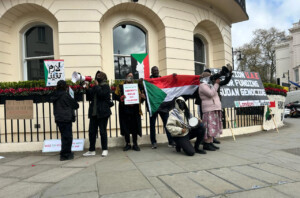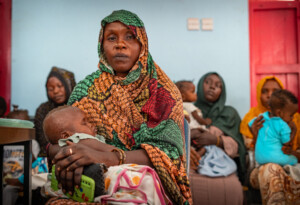Sudan OCHA bulletin 48: Darfuri refugees return from Chad to West Darfur
The UN Office for the Coordination of Humanitarian Affairs (OCHA) in Sudan reports in its latest bulletin that about 1,250 people reportedly returned from Chad to Habila locality. Crop production in Sudan is expected to be at above-average levels. The Sudan People’s Liberation Movement-North (SPLM-N) has signed an Action Plan with the UN to prevent the use of children in conflict. On 27 November, a 16-day campaign was launched in Khartoum with the aim to eliminate violence against women in Sudan. In October, 4,000 refugees from South Sudan arrived in White Nile.
The UN Office for the Coordination of Humanitarian Affairs (OCHA) in Sudan reports in its latest bulletin that about 1,250 people reportedly returned from Chad to Habila locality. Crop production in Sudan is expected to be at above-average levels. The Sudan People’s Liberation Movement-North (SPLM-N) has signed an Action Plan with the UN to prevent the use of children in conflict. On 27 November, a 16-day campaign was launched in Khartoum with the aim to eliminate violence against women in Sudan. In October, nearly 4,000 refugees from South Sudan arrived in White Nile.
The governmental Humanitarian Aid Commission (HAC) in West Darfur has received reports that about 1,250 people (250 families) returned from Chad to the area of Gobe in Habila locality in recent weeks. HAC and humanitarian partners are planning to visit the area to assess the number and needs of returnees.
Camps in the east of Chad host some 310,000 refugees from Darfur, according to the UN Refugee Agency (UNHCR). An inter-agency team assessing the needs of returnees from Chad in several locations in North Darfur in May 2016 reported that the returnees cited the following reasons for the their return: shortage of food and lack of livelihoods opportunities because of limited movements outside of camps, educational challenges in the camps, and improvement in the security situation in their areas of origin.
The International Organization for Migration (IOM) reported that an estimated 66,000 refugees returned, mainly from Chad, to West Darfur in 2015. More than 60 per cent of all the returnees are children.
Above-average grain production expected
The UN Food and Agriculture Organization (FAO) stated in its latest Global Information and Early Warning System (GIEWS) update for Sudan that while official estimates are not yet available, crop production is expected to be at above‑average levels.
The 2016 rainy season (June‑September) has generally been favourable, the OCHA bulletin reads. Since October, food security conditions have started to improve as newly harvested crops became available for local consumption.

The ongoing harvest is also providing additional labour opportunities and income for households. The demand for agricultural labour is likely to increase owing to the expected above-average production, in turn increasing local wage rates.
Despite this improved food security, about 3.6 million people in Sudan are estimated to be severely food insecure. This includes displaced people and refugees residing in camps in Darfur, as well as displaced and refugees in South Kordofan, according to the GIEWS report.
High levels of food insecurity are also reported among most vulnerable households in Kassala, Red Sea, and North Kordofan states.
 Prices of locally produced sorghum and millet—the main staple grains—began to decrease recently in most monitored markets with the start of the 2016 harvest.
Prices of locally produced sorghum and millet—the main staple grains—began to decrease recently in most monitored markets with the start of the 2016 harvest.
Despite the recent declines however, prices of sorghum and millet in October remained well above earlier levels this year, reflecting the tight domestic availabilities following the 2015 drought-reduced harvest.
Sorghum, millet, and wheat are the three main staple foods in Sudan. Sorghum is the staple food for most people living in Sudan. Millet is the preferred staple food in Darfur. In the northern areas (River Nile and Northern states) wheat is more common.
SPLM-N signs action plan to end child recruitment
On 23 November, the Sudan People’s Liberation Movement-North (SPLM-N) signed an Action Plan with the UN to end and prevent the recruitment and use of children in conflict.
The SPLM-N will ensure the release of children in their ranks and take the necessary measures to halt child recruitment and use. They also pledged to facilitate the reintegration of the children in their communities.
In March this year, the Government of Sudan signed an Action Plan with the UN to prevent the recruitment and use of children by Sudan’s security forces.
End Violence against Women campaign launched in Sudan
On 27 November, the UN Population Fund (UNFPA), the Sudanese Ministry of Welfare and Social Welfare, the Combating Violence against Women and Children Unit, UN agencies, international NGOs, and the Sudanese Parliamentary Women Association launched a 16-day campaign to eliminate violence against women in Sudan under the theme “Together for finance education and health for protecting women against violence”.
One of the major challenges affecting efforts to prevent and end violence against women and girls worldwide is the substantial funding shortfall. The campaign not only aims to affirm the political will to combat violence against women through effective policies, but also intends to mobilise resources to provide funds for health and education programmes targeting women and children.
As part of efforts to end violence against women and children, the Sudanese Parliamentary Women’s Association is working to include an article in Sudan’s Criminal Act that bans Female Genital Mutilation (FGM).
Almost 4,000 South Sudanese refugees arrive in White Nile in October
October marked the highest monthly arrival rate of South Sudanese refugees in White Nile state this year, with 3,962 individuals (1,552 households) registered.
As of 15 November, about 263,000 South Sudanese refugees have arrived in Sudan since December 2013. With continuing insecurity in South Sudan, a steady influx of new refugees is expected throughout December and into next year, the UNHCR says.
UNHCR and WFP have completed a series of assessments, including a food security assessment, a Standardized Expanded Nutrition Survey, a livelihoods assessment and a Cash-Based Transfer market and supply chain capacity assessment. Preliminary findings are currently being reviewed.











 and then
and then